Biometrics for Authentication: A Look at Past, Present, and Future
VerifiedAdded on 2020/03/28
|10
|2172
|41
Report
AI Summary
This report provides a comprehensive overview of biometrics for authentication, tracing its evolution from early fingerprinting techniques to contemporary multimodal systems. It delves into the core concepts of biometric identification, exploring the processes of registration, storage, and mapping of biometric data, and differentiates between identification and verification methods. The report highlights the significance of multimodal biometry in enhancing accuracy and security, as well as the accuracy of these systems, considering factors like false acceptance rates. It also addresses the increasing use of biometrics in various sectors such as finance, healthcare, and law enforcement. Furthermore, it emphasizes the importance of data protection and privacy concerns. Finally, the report concludes by discussing the future of biometrics, including the potential for new threats and the necessity for robust safeguards to protect personal data.

Running Head: BIOMETRICS FOR AUTHENTICATION: PAST, PRESENT AND
FUTURE
Biometrics for authentication: Past, Present and Future
Student’s name
Name of the Institute
FUTURE
Biometrics for authentication: Past, Present and Future
Student’s name
Name of the Institute
Paraphrase This Document
Need a fresh take? Get an instant paraphrase of this document with our AI Paraphraser
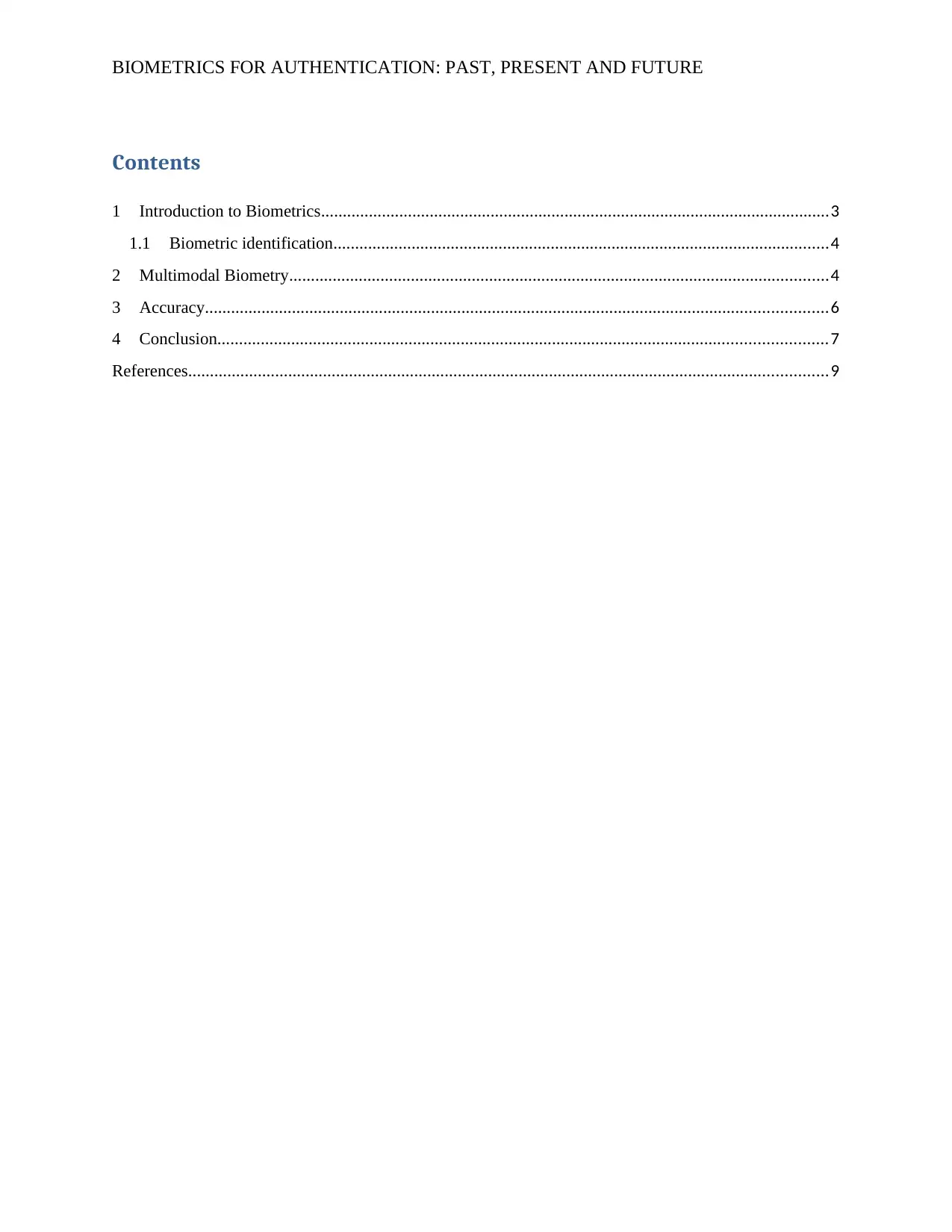
BIOMETRICS FOR AUTHENTICATION: PAST, PRESENT AND FUTURE
Contents
1 Introduction to Biometrics.....................................................................................................................3
1.1 Biometric identification..................................................................................................................4
2 Multimodal Biometry............................................................................................................................4
3 Accuracy...............................................................................................................................................6
4 Conclusion............................................................................................................................................7
References...................................................................................................................................................9
Contents
1 Introduction to Biometrics.....................................................................................................................3
1.1 Biometric identification..................................................................................................................4
2 Multimodal Biometry............................................................................................................................4
3 Accuracy...............................................................................................................................................6
4 Conclusion............................................................................................................................................7
References...................................................................................................................................................9
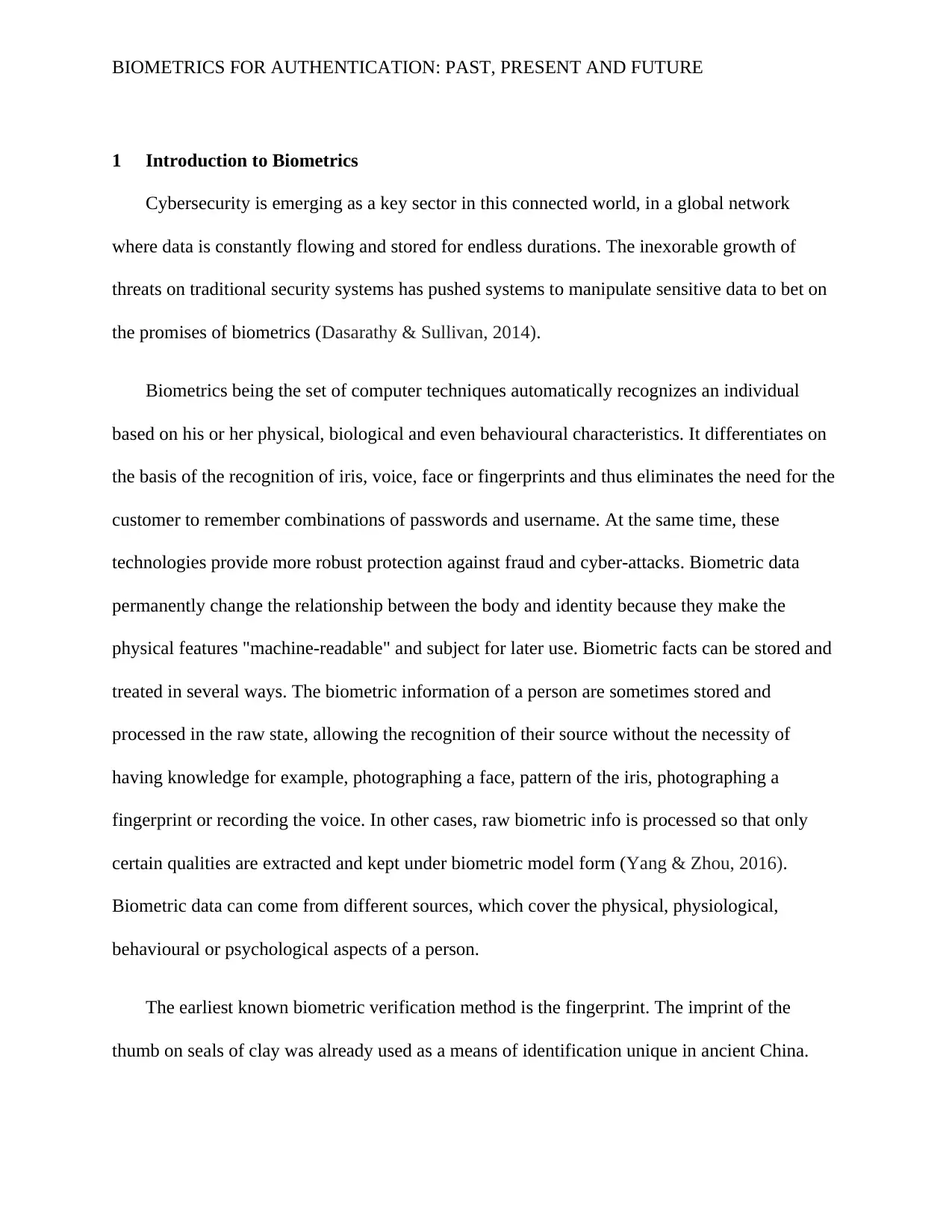
BIOMETRICS FOR AUTHENTICATION: PAST, PRESENT AND FUTURE
1 Introduction to Biometrics
Cybersecurity is emerging as a key sector in this connected world, in a global network
where data is constantly flowing and stored for endless durations. The inexorable growth of
threats on traditional security systems has pushed systems to manipulate sensitive data to bet on
the promises of biometrics (Dasarathy & Sullivan, 2014).
Biometrics being the set of computer techniques automatically recognizes an individual
based on his or her physical, biological and even behavioural characteristics. It differentiates on
the basis of the recognition of iris, voice, face or fingerprints and thus eliminates the need for the
customer to remember combinations of passwords and username. At the same time, these
technologies provide more robust protection against fraud and cyber-attacks. Biometric data
permanently change the relationship between the body and identity because they make the
physical features "machine-readable" and subject for later use. Biometric facts can be stored and
treated in several ways. The biometric information of a person are sometimes stored and
processed in the raw state, allowing the recognition of their source without the necessity of
having knowledge for example, photographing a face, pattern of the iris, photographing a
fingerprint or recording the voice. In other cases, raw biometric info is processed so that only
certain qualities are extracted and kept under biometric model form (Yang & Zhou, 2016).
Biometric data can come from different sources, which cover the physical, physiological,
behavioural or psychological aspects of a person.
The earliest known biometric verification method is the fingerprint. The imprint of the
thumb on seals of clay was already used as a means of identification unique in ancient China.
1 Introduction to Biometrics
Cybersecurity is emerging as a key sector in this connected world, in a global network
where data is constantly flowing and stored for endless durations. The inexorable growth of
threats on traditional security systems has pushed systems to manipulate sensitive data to bet on
the promises of biometrics (Dasarathy & Sullivan, 2014).
Biometrics being the set of computer techniques automatically recognizes an individual
based on his or her physical, biological and even behavioural characteristics. It differentiates on
the basis of the recognition of iris, voice, face or fingerprints and thus eliminates the need for the
customer to remember combinations of passwords and username. At the same time, these
technologies provide more robust protection against fraud and cyber-attacks. Biometric data
permanently change the relationship between the body and identity because they make the
physical features "machine-readable" and subject for later use. Biometric facts can be stored and
treated in several ways. The biometric information of a person are sometimes stored and
processed in the raw state, allowing the recognition of their source without the necessity of
having knowledge for example, photographing a face, pattern of the iris, photographing a
fingerprint or recording the voice. In other cases, raw biometric info is processed so that only
certain qualities are extracted and kept under biometric model form (Yang & Zhou, 2016).
Biometric data can come from different sources, which cover the physical, physiological,
behavioural or psychological aspects of a person.
The earliest known biometric verification method is the fingerprint. The imprint of the
thumb on seals of clay was already used as a means of identification unique in ancient China.
⊘ This is a preview!⊘
Do you want full access?
Subscribe today to unlock all pages.

Trusted by 1+ million students worldwide
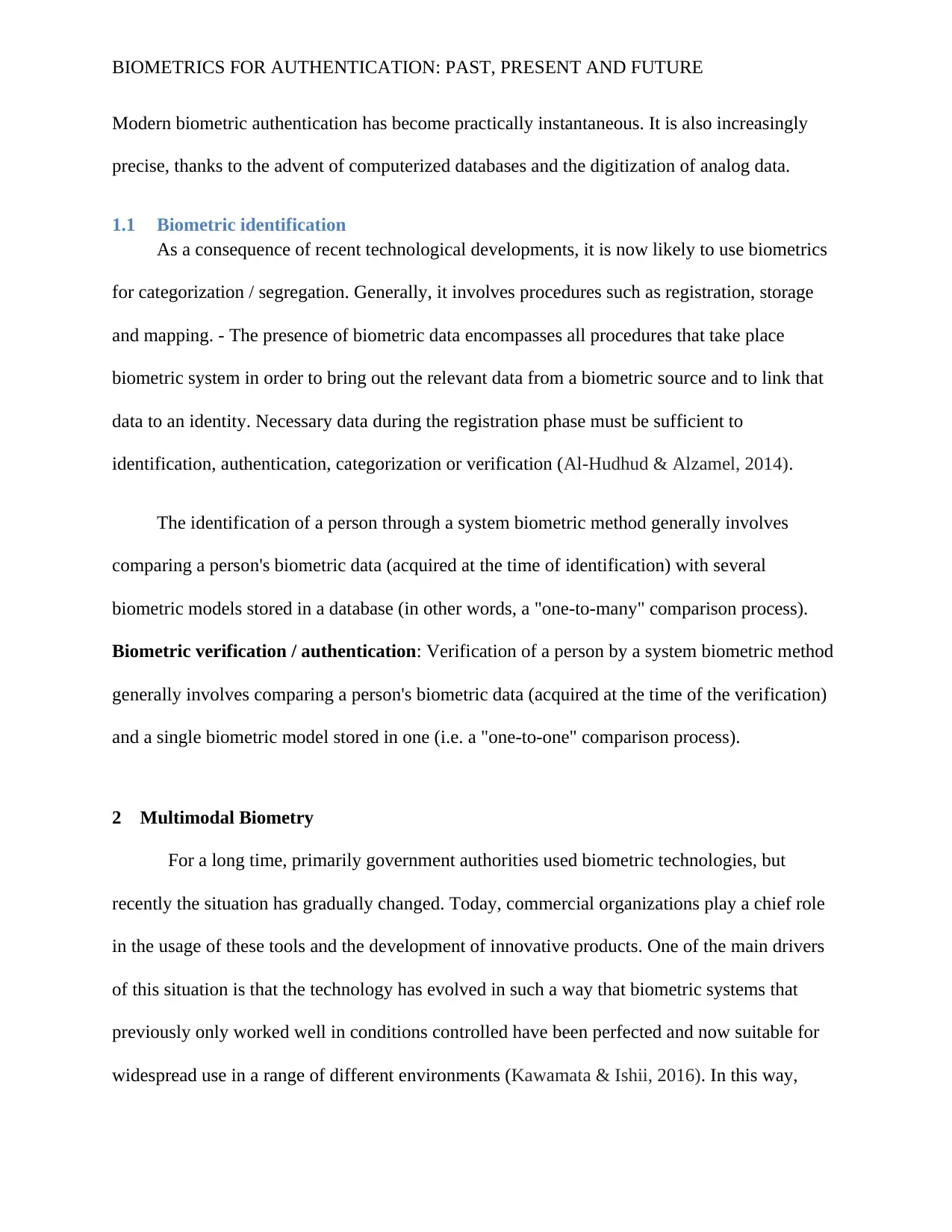
BIOMETRICS FOR AUTHENTICATION: PAST, PRESENT AND FUTURE
Modern biometric authentication has become practically instantaneous. It is also increasingly
precise, thanks to the advent of computerized databases and the digitization of analog data.
1.1 Biometric identification
As a consequence of recent technological developments, it is now likely to use biometrics
for categorization / segregation. Generally, it involves procedures such as registration, storage
and mapping. - The presence of biometric data encompasses all procedures that take place
biometric system in order to bring out the relevant data from a biometric source and to link that
data to an identity. Necessary data during the registration phase must be sufficient to
identification, authentication, categorization or verification (Al-Hudhud & Alzamel, 2014).
The identification of a person through a system biometric method generally involves
comparing a person's biometric data (acquired at the time of identification) with several
biometric models stored in a database (in other words, a "one-to-many" comparison process).
Biometric verification / authentication: Verification of a person by a system biometric method
generally involves comparing a person's biometric data (acquired at the time of the verification)
and a single biometric model stored in one (i.e. a "one-to-one" comparison process).
2 Multimodal Biometry
For a long time, primarily government authorities used biometric technologies, but
recently the situation has gradually changed. Today, commercial organizations play a chief role
in the usage of these tools and the development of innovative products. One of the main drivers
of this situation is that the technology has evolved in such a way that biometric systems that
previously only worked well in conditions controlled have been perfected and now suitable for
widespread use in a range of different environments (Kawamata & Ishii, 2016). In this way,
Modern biometric authentication has become practically instantaneous. It is also increasingly
precise, thanks to the advent of computerized databases and the digitization of analog data.
1.1 Biometric identification
As a consequence of recent technological developments, it is now likely to use biometrics
for categorization / segregation. Generally, it involves procedures such as registration, storage
and mapping. - The presence of biometric data encompasses all procedures that take place
biometric system in order to bring out the relevant data from a biometric source and to link that
data to an identity. Necessary data during the registration phase must be sufficient to
identification, authentication, categorization or verification (Al-Hudhud & Alzamel, 2014).
The identification of a person through a system biometric method generally involves
comparing a person's biometric data (acquired at the time of identification) with several
biometric models stored in a database (in other words, a "one-to-many" comparison process).
Biometric verification / authentication: Verification of a person by a system biometric method
generally involves comparing a person's biometric data (acquired at the time of the verification)
and a single biometric model stored in one (i.e. a "one-to-one" comparison process).
2 Multimodal Biometry
For a long time, primarily government authorities used biometric technologies, but
recently the situation has gradually changed. Today, commercial organizations play a chief role
in the usage of these tools and the development of innovative products. One of the main drivers
of this situation is that the technology has evolved in such a way that biometric systems that
previously only worked well in conditions controlled have been perfected and now suitable for
widespread use in a range of different environments (Kawamata & Ishii, 2016). In this way,
Paraphrase This Document
Need a fresh take? Get an instant paraphrase of this document with our AI Paraphraser
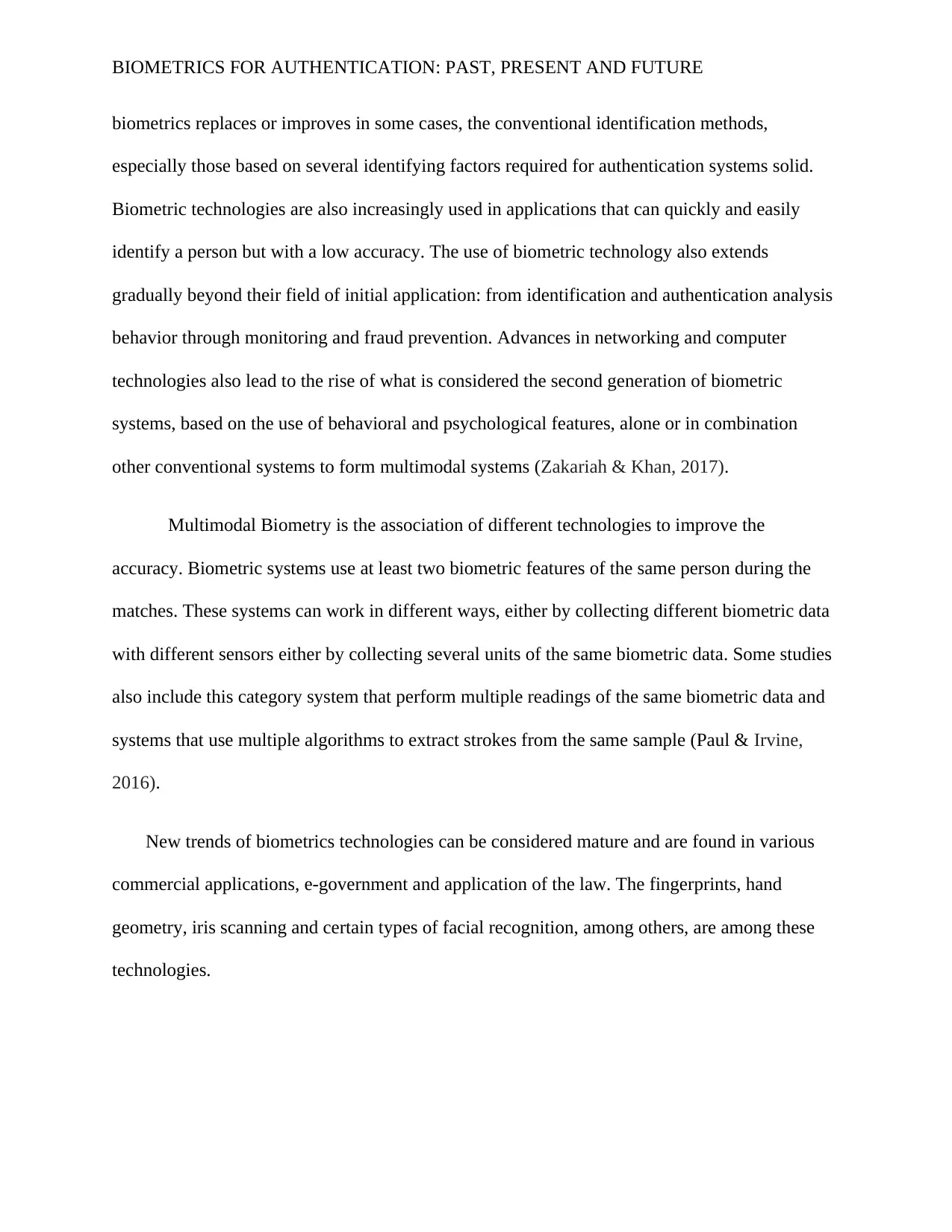
BIOMETRICS FOR AUTHENTICATION: PAST, PRESENT AND FUTURE
biometrics replaces or improves in some cases, the conventional identification methods,
especially those based on several identifying factors required for authentication systems solid.
Biometric technologies are also increasingly used in applications that can quickly and easily
identify a person but with a low accuracy. The use of biometric technology also extends
gradually beyond their field of initial application: from identification and authentication analysis
behavior through monitoring and fraud prevention. Advances in networking and computer
technologies also lead to the rise of what is considered the second generation of biometric
systems, based on the use of behavioral and psychological features, alone or in combination
other conventional systems to form multimodal systems (Zakariah & Khan, 2017).
Multimodal Biometry is the association of different technologies to improve the
accuracy. Biometric systems use at least two biometric features of the same person during the
matches. These systems can work in different ways, either by collecting different biometric data
with different sensors either by collecting several units of the same biometric data. Some studies
also include this category system that perform multiple readings of the same biometric data and
systems that use multiple algorithms to extract strokes from the same sample (Paul & Irvine,
2016).
New trends of biometrics technologies can be considered mature and are found in various
commercial applications, e-government and application of the law. The fingerprints, hand
geometry, iris scanning and certain types of facial recognition, among others, are among these
technologies.
biometrics replaces or improves in some cases, the conventional identification methods,
especially those based on several identifying factors required for authentication systems solid.
Biometric technologies are also increasingly used in applications that can quickly and easily
identify a person but with a low accuracy. The use of biometric technology also extends
gradually beyond their field of initial application: from identification and authentication analysis
behavior through monitoring and fraud prevention. Advances in networking and computer
technologies also lead to the rise of what is considered the second generation of biometric
systems, based on the use of behavioral and psychological features, alone or in combination
other conventional systems to form multimodal systems (Zakariah & Khan, 2017).
Multimodal Biometry is the association of different technologies to improve the
accuracy. Biometric systems use at least two biometric features of the same person during the
matches. These systems can work in different ways, either by collecting different biometric data
with different sensors either by collecting several units of the same biometric data. Some studies
also include this category system that perform multiple readings of the same biometric data and
systems that use multiple algorithms to extract strokes from the same sample (Paul & Irvine,
2016).
New trends of biometrics technologies can be considered mature and are found in various
commercial applications, e-government and application of the law. The fingerprints, hand
geometry, iris scanning and certain types of facial recognition, among others, are among these
technologies.
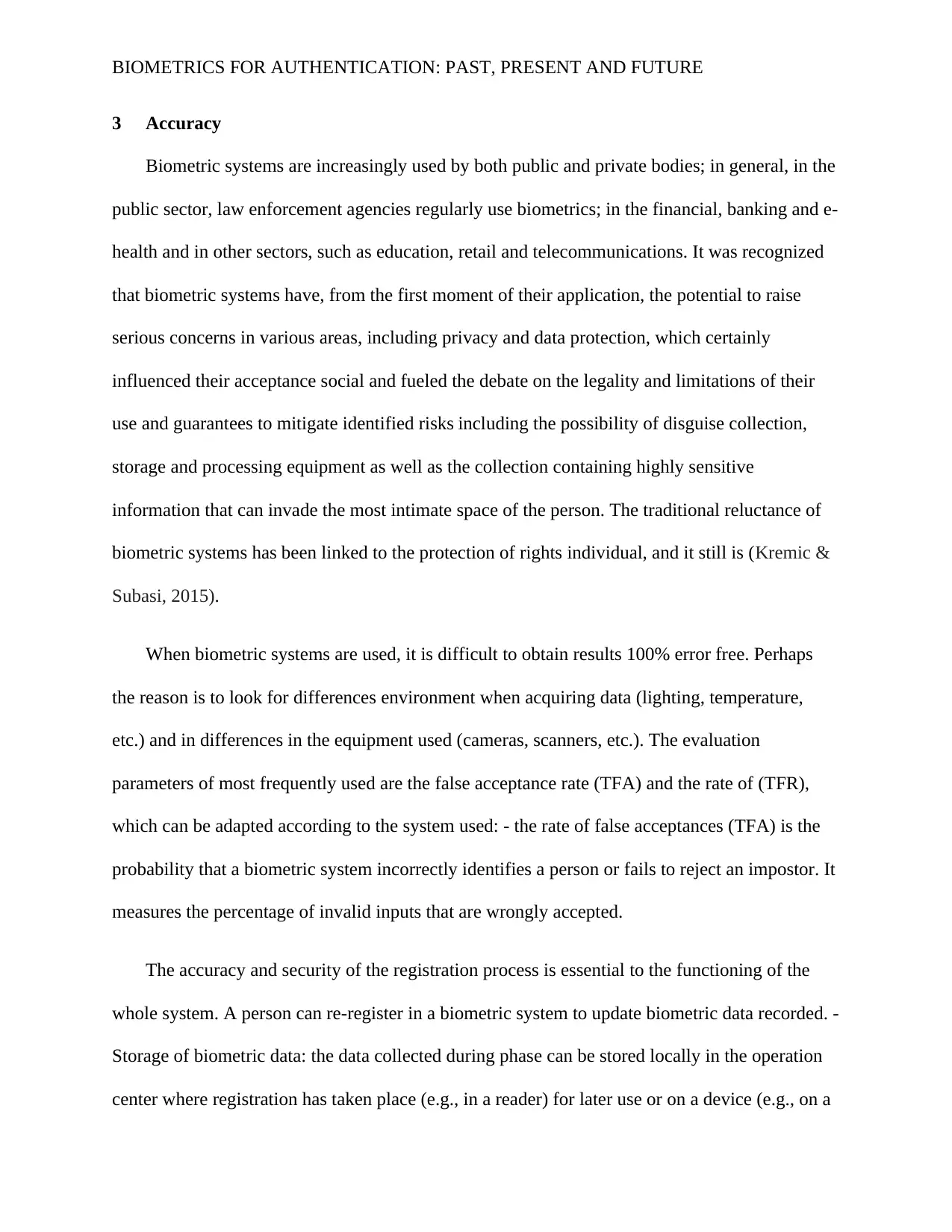
BIOMETRICS FOR AUTHENTICATION: PAST, PRESENT AND FUTURE
3 Accuracy
Biometric systems are increasingly used by both public and private bodies; in general, in the
public sector, law enforcement agencies regularly use biometrics; in the financial, banking and e-
health and in other sectors, such as education, retail and telecommunications. It was recognized
that biometric systems have, from the first moment of their application, the potential to raise
serious concerns in various areas, including privacy and data protection, which certainly
influenced their acceptance social and fueled the debate on the legality and limitations of their
use and guarantees to mitigate identified risks including the possibility of disguise collection,
storage and processing equipment as well as the collection containing highly sensitive
information that can invade the most intimate space of the person. The traditional reluctance of
biometric systems has been linked to the protection of rights individual, and it still is (Kremic &
Subasi, 2015).
When biometric systems are used, it is difficult to obtain results 100% error free. Perhaps
the reason is to look for differences environment when acquiring data (lighting, temperature,
etc.) and in differences in the equipment used (cameras, scanners, etc.). The evaluation
parameters of most frequently used are the false acceptance rate (TFA) and the rate of (TFR),
which can be adapted according to the system used: - the rate of false acceptances (TFA) is the
probability that a biometric system incorrectly identifies a person or fails to reject an impostor. It
measures the percentage of invalid inputs that are wrongly accepted.
The accuracy and security of the registration process is essential to the functioning of the
whole system. A person can re-register in a biometric system to update biometric data recorded. -
Storage of biometric data: the data collected during phase can be stored locally in the operation
center where registration has taken place (e.g., in a reader) for later use or on a device (e.g., on a
3 Accuracy
Biometric systems are increasingly used by both public and private bodies; in general, in the
public sector, law enforcement agencies regularly use biometrics; in the financial, banking and e-
health and in other sectors, such as education, retail and telecommunications. It was recognized
that biometric systems have, from the first moment of their application, the potential to raise
serious concerns in various areas, including privacy and data protection, which certainly
influenced their acceptance social and fueled the debate on the legality and limitations of their
use and guarantees to mitigate identified risks including the possibility of disguise collection,
storage and processing equipment as well as the collection containing highly sensitive
information that can invade the most intimate space of the person. The traditional reluctance of
biometric systems has been linked to the protection of rights individual, and it still is (Kremic &
Subasi, 2015).
When biometric systems are used, it is difficult to obtain results 100% error free. Perhaps
the reason is to look for differences environment when acquiring data (lighting, temperature,
etc.) and in differences in the equipment used (cameras, scanners, etc.). The evaluation
parameters of most frequently used are the false acceptance rate (TFA) and the rate of (TFR),
which can be adapted according to the system used: - the rate of false acceptances (TFA) is the
probability that a biometric system incorrectly identifies a person or fails to reject an impostor. It
measures the percentage of invalid inputs that are wrongly accepted.
The accuracy and security of the registration process is essential to the functioning of the
whole system. A person can re-register in a biometric system to update biometric data recorded. -
Storage of biometric data: the data collected during phase can be stored locally in the operation
center where registration has taken place (e.g., in a reader) for later use or on a device (e.g., on a
⊘ This is a preview!⊘
Do you want full access?
Subscribe today to unlock all pages.

Trusted by 1+ million students worldwide
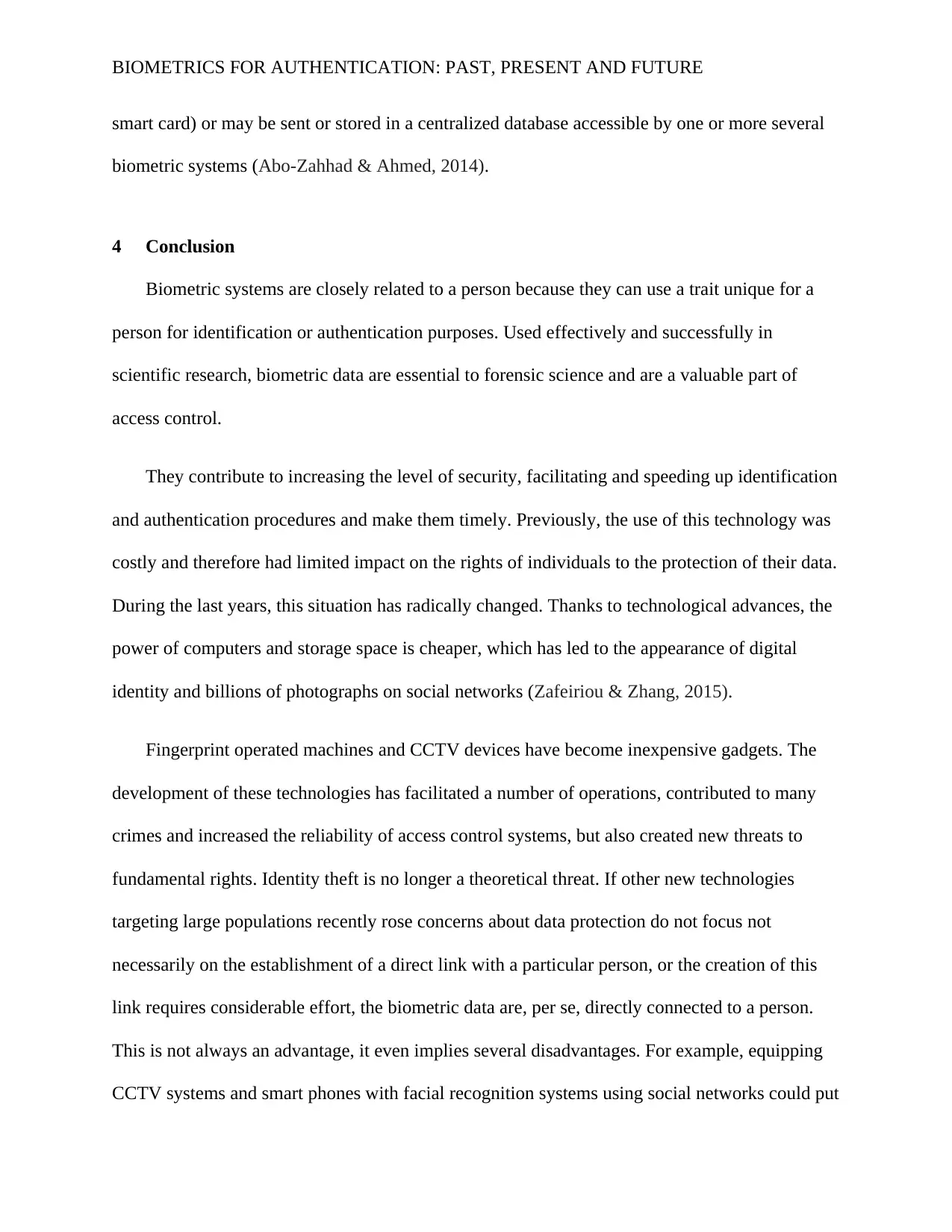
BIOMETRICS FOR AUTHENTICATION: PAST, PRESENT AND FUTURE
smart card) or may be sent or stored in a centralized database accessible by one or more several
biometric systems (Abo-Zahhad & Ahmed, 2014).
4 Conclusion
Biometric systems are closely related to a person because they can use a trait unique for a
person for identification or authentication purposes. Used effectively and successfully in
scientific research, biometric data are essential to forensic science and are a valuable part of
access control.
They contribute to increasing the level of security, facilitating and speeding up identification
and authentication procedures and make them timely. Previously, the use of this technology was
costly and therefore had limited impact on the rights of individuals to the protection of their data.
During the last years, this situation has radically changed. Thanks to technological advances, the
power of computers and storage space is cheaper, which has led to the appearance of digital
identity and billions of photographs on social networks (Zafeiriou & Zhang, 2015).
Fingerprint operated machines and CCTV devices have become inexpensive gadgets. The
development of these technologies has facilitated a number of operations, contributed to many
crimes and increased the reliability of access control systems, but also created new threats to
fundamental rights. Identity theft is no longer a theoretical threat. If other new technologies
targeting large populations recently rose concerns about data protection do not focus not
necessarily on the establishment of a direct link with a particular person, or the creation of this
link requires considerable effort, the biometric data are, per se, directly connected to a person.
This is not always an advantage, it even implies several disadvantages. For example, equipping
CCTV systems and smart phones with facial recognition systems using social networks could put
smart card) or may be sent or stored in a centralized database accessible by one or more several
biometric systems (Abo-Zahhad & Ahmed, 2014).
4 Conclusion
Biometric systems are closely related to a person because they can use a trait unique for a
person for identification or authentication purposes. Used effectively and successfully in
scientific research, biometric data are essential to forensic science and are a valuable part of
access control.
They contribute to increasing the level of security, facilitating and speeding up identification
and authentication procedures and make them timely. Previously, the use of this technology was
costly and therefore had limited impact on the rights of individuals to the protection of their data.
During the last years, this situation has radically changed. Thanks to technological advances, the
power of computers and storage space is cheaper, which has led to the appearance of digital
identity and billions of photographs on social networks (Zafeiriou & Zhang, 2015).
Fingerprint operated machines and CCTV devices have become inexpensive gadgets. The
development of these technologies has facilitated a number of operations, contributed to many
crimes and increased the reliability of access control systems, but also created new threats to
fundamental rights. Identity theft is no longer a theoretical threat. If other new technologies
targeting large populations recently rose concerns about data protection do not focus not
necessarily on the establishment of a direct link with a particular person, or the creation of this
link requires considerable effort, the biometric data are, per se, directly connected to a person.
This is not always an advantage, it even implies several disadvantages. For example, equipping
CCTV systems and smart phones with facial recognition systems using social networks could put
Paraphrase This Document
Need a fresh take? Get an instant paraphrase of this document with our AI Paraphraser
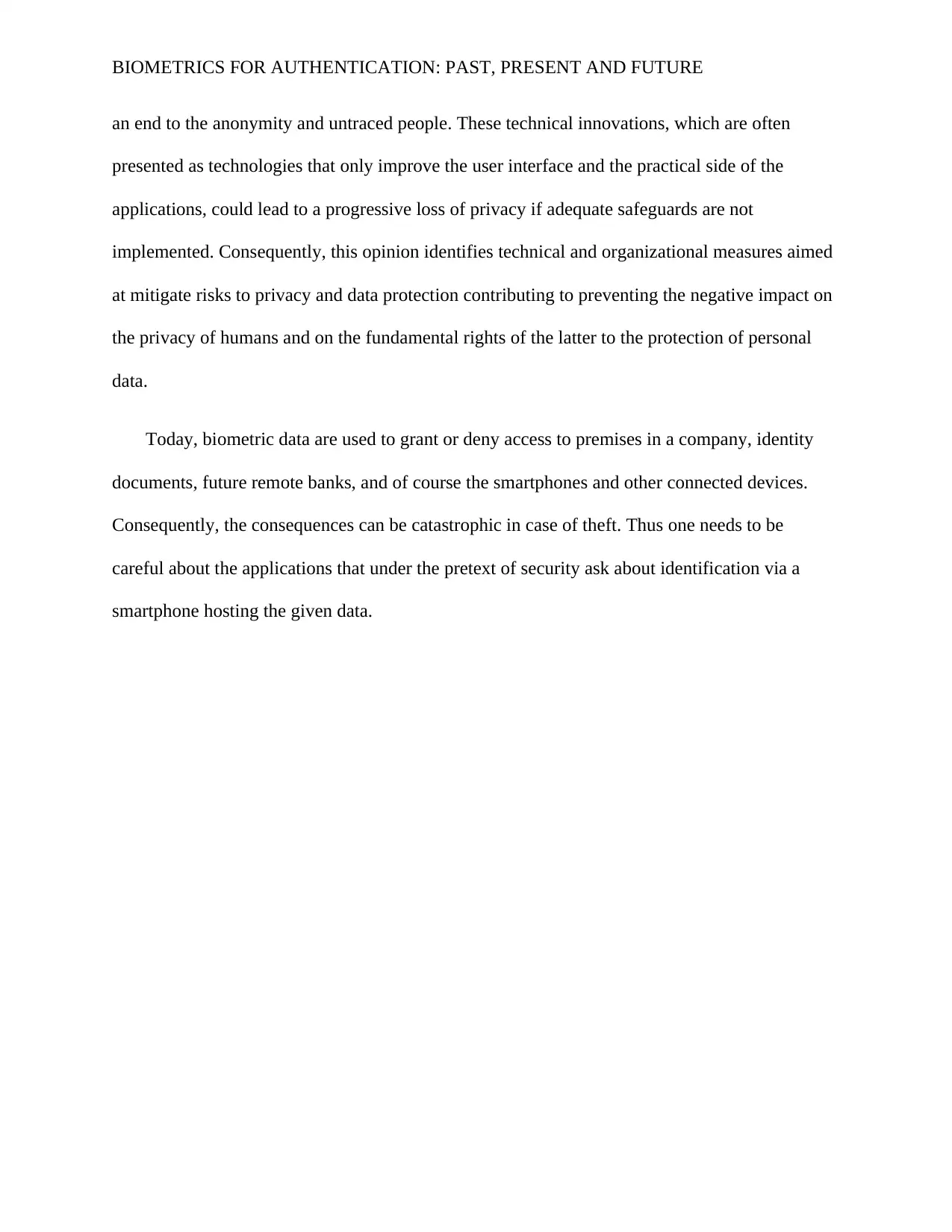
BIOMETRICS FOR AUTHENTICATION: PAST, PRESENT AND FUTURE
an end to the anonymity and untraced people. These technical innovations, which are often
presented as technologies that only improve the user interface and the practical side of the
applications, could lead to a progressive loss of privacy if adequate safeguards are not
implemented. Consequently, this opinion identifies technical and organizational measures aimed
at mitigate risks to privacy and data protection contributing to preventing the negative impact on
the privacy of humans and on the fundamental rights of the latter to the protection of personal
data.
Today, biometric data are used to grant or deny access to premises in a company, identity
documents, future remote banks, and of course the smartphones and other connected devices.
Consequently, the consequences can be catastrophic in case of theft. Thus one needs to be
careful about the applications that under the pretext of security ask about identification via a
smartphone hosting the given data.
an end to the anonymity and untraced people. These technical innovations, which are often
presented as technologies that only improve the user interface and the practical side of the
applications, could lead to a progressive loss of privacy if adequate safeguards are not
implemented. Consequently, this opinion identifies technical and organizational measures aimed
at mitigate risks to privacy and data protection contributing to preventing the negative impact on
the privacy of humans and on the fundamental rights of the latter to the protection of personal
data.
Today, biometric data are used to grant or deny access to premises in a company, identity
documents, future remote banks, and of course the smartphones and other connected devices.
Consequently, the consequences can be catastrophic in case of theft. Thus one needs to be
careful about the applications that under the pretext of security ask about identification via a
smartphone hosting the given data.
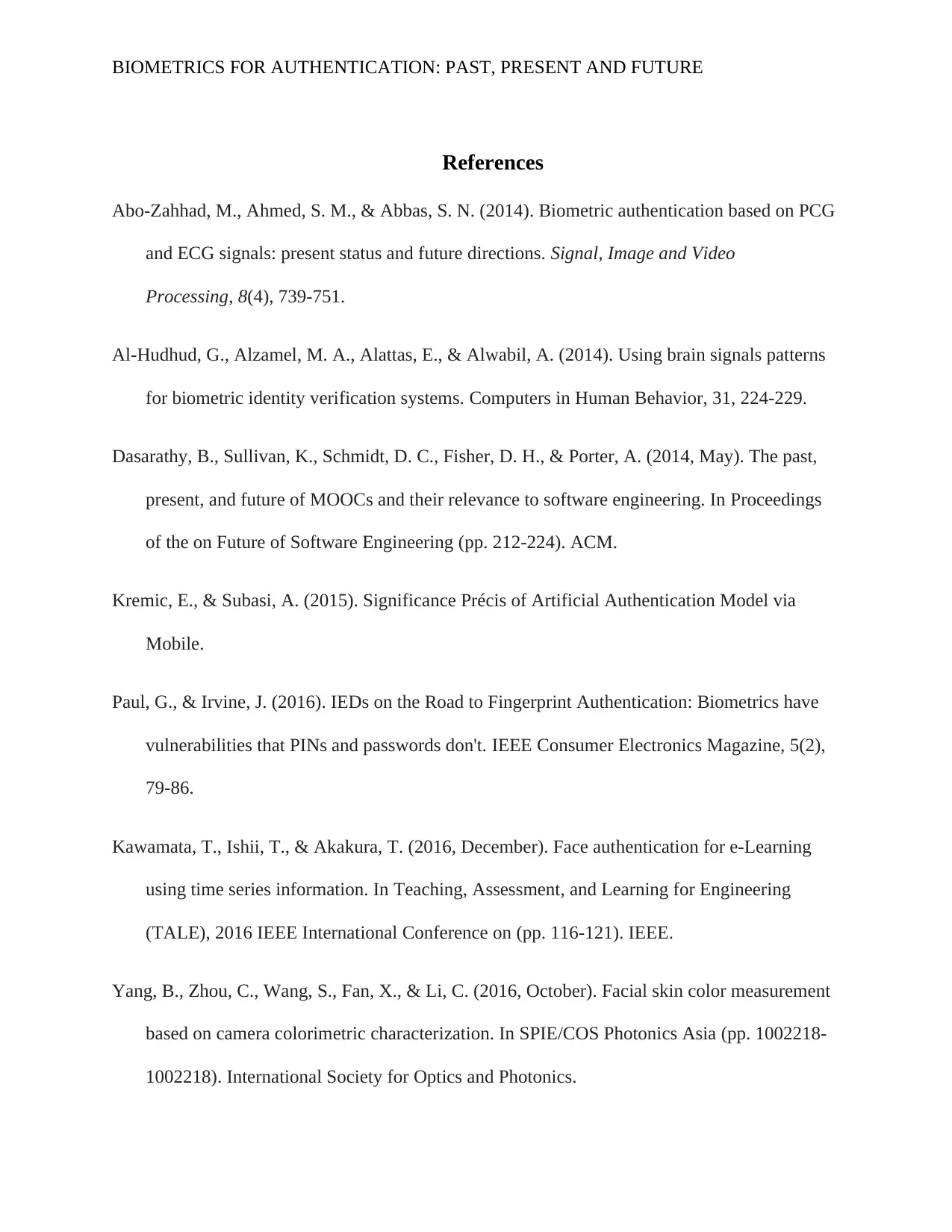
BIOMETRICS FOR AUTHENTICATION: PAST, PRESENT AND FUTURE
References
Abo-Zahhad, M., Ahmed, S. M., & Abbas, S. N. (2014). Biometric authentication based on PCG
and ECG signals: present status and future directions. Signal, Image and Video
Processing, 8(4), 739-751.
Al-Hudhud, G., Alzamel, M. A., Alattas, E., & Alwabil, A. (2014). Using brain signals patterns
for biometric identity verification systems. Computers in Human Behavior, 31, 224-229.
Dasarathy, B., Sullivan, K., Schmidt, D. C., Fisher, D. H., & Porter, A. (2014, May). The past,
present, and future of MOOCs and their relevance to software engineering. In Proceedings
of the on Future of Software Engineering (pp. 212-224). ACM.
Kremic, E., & Subasi, A. (2015). Significance Précis of Artificial Authentication Model via
Mobile.
Paul, G., & Irvine, J. (2016). IEDs on the Road to Fingerprint Authentication: Biometrics have
vulnerabilities that PINs and passwords don't. IEEE Consumer Electronics Magazine, 5(2),
79-86.
Kawamata, T., Ishii, T., & Akakura, T. (2016, December). Face authentication for e-Learning
using time series information. In Teaching, Assessment, and Learning for Engineering
(TALE), 2016 IEEE International Conference on (pp. 116-121). IEEE.
Yang, B., Zhou, C., Wang, S., Fan, X., & Li, C. (2016, October). Facial skin color measurement
based on camera colorimetric characterization. In SPIE/COS Photonics Asia (pp. 1002218-
1002218). International Society for Optics and Photonics.
References
Abo-Zahhad, M., Ahmed, S. M., & Abbas, S. N. (2014). Biometric authentication based on PCG
and ECG signals: present status and future directions. Signal, Image and Video
Processing, 8(4), 739-751.
Al-Hudhud, G., Alzamel, M. A., Alattas, E., & Alwabil, A. (2014). Using brain signals patterns
for biometric identity verification systems. Computers in Human Behavior, 31, 224-229.
Dasarathy, B., Sullivan, K., Schmidt, D. C., Fisher, D. H., & Porter, A. (2014, May). The past,
present, and future of MOOCs and their relevance to software engineering. In Proceedings
of the on Future of Software Engineering (pp. 212-224). ACM.
Kremic, E., & Subasi, A. (2015). Significance Précis of Artificial Authentication Model via
Mobile.
Paul, G., & Irvine, J. (2016). IEDs on the Road to Fingerprint Authentication: Biometrics have
vulnerabilities that PINs and passwords don't. IEEE Consumer Electronics Magazine, 5(2),
79-86.
Kawamata, T., Ishii, T., & Akakura, T. (2016, December). Face authentication for e-Learning
using time series information. In Teaching, Assessment, and Learning for Engineering
(TALE), 2016 IEEE International Conference on (pp. 116-121). IEEE.
Yang, B., Zhou, C., Wang, S., Fan, X., & Li, C. (2016, October). Facial skin color measurement
based on camera colorimetric characterization. In SPIE/COS Photonics Asia (pp. 1002218-
1002218). International Society for Optics and Photonics.
⊘ This is a preview!⊘
Do you want full access?
Subscribe today to unlock all pages.

Trusted by 1+ million students worldwide

BIOMETRICS FOR AUTHENTICATION: PAST, PRESENT AND FUTURE
Zafeiriou, S., Zhang, C., & Zhang, Z. (2015). A survey on face detection in the wild: past,
present and future. Computer Vision and Image Understanding, 138, 1-24.
Zakariah, M., Khan, M. K., & Malik, H. (2017). Digital multimedia audio forensics: past, present
and future. Multimedia Tools and Applications, 1-32.
.
Zafeiriou, S., Zhang, C., & Zhang, Z. (2015). A survey on face detection in the wild: past,
present and future. Computer Vision and Image Understanding, 138, 1-24.
Zakariah, M., Khan, M. K., & Malik, H. (2017). Digital multimedia audio forensics: past, present
and future. Multimedia Tools and Applications, 1-32.
.
1 out of 10
Related Documents
Your All-in-One AI-Powered Toolkit for Academic Success.
+13062052269
info@desklib.com
Available 24*7 on WhatsApp / Email
![[object Object]](/_next/static/media/star-bottom.7253800d.svg)
Unlock your academic potential
Copyright © 2020–2025 A2Z Services. All Rights Reserved. Developed and managed by ZUCOL.




